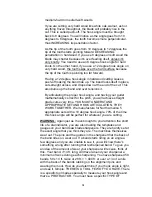
14
looks like a gray sharpening stone that was turned into paste. It can be found at
an auto parts store where both coarse and fine is available. Both grits are useful
to polish trunnions, miter slots, and the kinds of roughness or binding often found
on machine tools.
MITER GAUGE AND SLOT
If the miter gauge binds in the slot, slide it along the slot to find out where it
binds. Use a fine file dragged along the edge of the slot. Then polish the slot and
the miter gauge bar with some fine emery cloth. A piece of oak to back up the
emery cloth will keep the repair flat and square. Frankly, a miter gauge is of very
little use on a bandsaw so don’t waste too much time adjusting it.
ADJUSTING THE FENCE
Fence and Blade drift
Blade drift means the blade isn’t cutting
parallel to the fence. Every blade will
cut in a slightly different manner and
you may have to adjust the fence angle
to compensate for this drift. To check
blade drift, mark a straight line on a
board 24" long, rip the board freehand
while carefully following the line About
halfway, through the cut, stop the saw
and leave the board in place. Mark the
side of the board on the saw table with
a soft pencil. This line indicates the
appropriate angle for the fence. Move and
adjust the fence parallel to this line (and
therefore parallel to the direction that the particular blade wants to cut).The fence
angle may be adjusted by loosening the top bolt in the fence assembly. Pivot the
fence about the roll pin and tighten the bolt. (SEE FIGURE 28 FENCE
ADJUSTMENT BOLT).
THROAT PLATE ADJUSTMENT
The height of the throat plate is adjusted by 4 screws. A fine screwdriver may be
used to adjust the plate absolutely flush to the table.(SEE FIGURE 29 THROAT
PLATE ADJUSTMENT
Summary of Contents for MM 16
Page 25: ...24 ...
Page 27: ...26 ...
Page 29: ...28 ...
Page 32: ...31 ...
Page 33: ...32 NOTE THAT PARTS WITHOUT A CODE ARE NORMALLY STOCK FASTENERS OR WASHERS ETC ...
















































